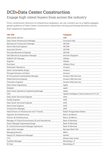Looking back, I am very glad that I was working as a writer during the pandemic. The supply for my work is, well, whatever my brain manages to whip up, and the demand remained mostly unchanged.
In contrast to my tiny one-woman supply chain of intangible goods, the data center construction supply chain was hit by a tidal wave of challenges.
Production and manufacturing came to a standstill, and construction became even harder as social distancing regulations were introduced, with many people either terrified of getting sick or already sick.
So given that demand for the data center industry was growing, but buildings were not actually getting built, in what position did this leave the supply chain?
To quote Oracle’s vice president of Data Center Engineering, Craig Pennington, during the DCD>Connect Silicon Valley panel discussion, What new data center design methodology will collapsing supply chains and the current construction tsunami leave us with?, it is a ‘horrendous’ one.
“We're in this horrendous position where the supply chain has really been affected by what's happened over the last two and a half years. The requirement for cloud services is continuing to grow unabated.
“I'm finding myself in certain markets where I'm taking everything that's available. It doesn't matter what's coming onto the market, I'm buying it because we have to keep ahead of that demand.”
Unlike when the general public ran to the supermarkets to stockpile everything they could get their hands on, due to a false perception of shortage, the data center supply chain is in a very real situation where demand is massively outweighed by supply, and companies are at war over resources: materials, products, and people.
“That’s just with cloud growth, then you've got to think about construction workers and transportation workers, which are now weighing against us,” said Pennington.
“That means you have to plan and deal with your partners in a way where you've got to be far more inclusive, you've got to tell them what's going to happen and where you're going and treat it as a partnership and not as an arm's length transaction. Because if you don't, they won't trust you to go away and buy the raw materials to produce the equipment you need. And if you haven't planned out 12 to 18 months in advance, you are not getting the parts you need.”
As a result, companies are truly rethinking their supply chain in order to keep up.
“The supply chain issue has changed our thinking because we've got customers that are pre-buying capacity that we haven't even bought from the supply chain,” explained Bruno Berti, vice president of Product Management, NTT.
“So we're starting to change our thinking as well, and we're not only talking about building an initial amount of capacity. We're putting orders in with our suppliers, anticipating builds that we don't even have committed. We're becoming an inventory management provider.”
But capacity planning and forecasting isn’t really new, it has just been made more challenging.
“One of the challenges that I saw starting to happen maybe five years ago, and that's capacity planning and forecasting. When I started in the business, it was important for us to start forecasting. We're getting a five-year agreement or an eight-year agreement with one of our providers, so let's forecast for those eight years, “ said Berti.
“Some companies did it really well. I'd say most companies did it better than they do today. Today, I think forecasting and capacity planning is really a crapshoot. Three years ago, customers started hedging their bets. They didn't want to spend money. So they were relying on us to hold that inventory and say, I'll buy one, but please save four for me.”
However, this ‘reserving’ format is currently not possible, with there already not enough to go around.
“I can't tell you how hard it is to get capacity in certain locations based on raw customer demand,” Pennington told the DCD>Connect audience. “The world has found ways to exploit the internet where we never thought it would be necessary or possible. We just need more capacity.”
Demand is not the only obstacle to the supply chain. Both Berti and Pennington touched on what seems to be a bit of a sore spot for both companies, and that is regulation.
“I will say the one thing we haven't alluded to yet, in the backdrop of all of this, is that government regulation and requirements around sustainability have not changed one iota,” Pennington noted.
“So this is another constraining factor on us. Not only do we have to do it more quickly with less supply, but it must be cleaner in doing so. We need to fundamentally be able to pivot and do things in a much more sustainable, much more linear way with a supply chain.”
Berti’s take on the matter is that regulation is significantly hindering the industry, as it is at the moment.
“I don't think regulation should be driving technology. It really is the partnership between the supplier and the consumer or buyer that lets us innovate.
“I have a lot of customers that are really pushing the envelope on sustainability. Yet, when they give me the contract, and we negotiate, the SLAs are still such that I can't operate at that PUE. They want me to operate within these humidity guidelines that don't make sense, and follow these temperature guidelines that were done in [something like] 2015. But the ASHRAE guidelines have changed a lot, and many companies haven't adopted the newest standards. So when you tell them that their equipment can handle it, they disagree.”
Ultimately, getting the supply chain moving smoothly again needs to be an industry-wide effort, with individuals at every step of the process on the same page. It is likely that we will continue to slowly grind on for the time being, but just as a traffic jam eventually eases, there also will be a real return to business as usual.



